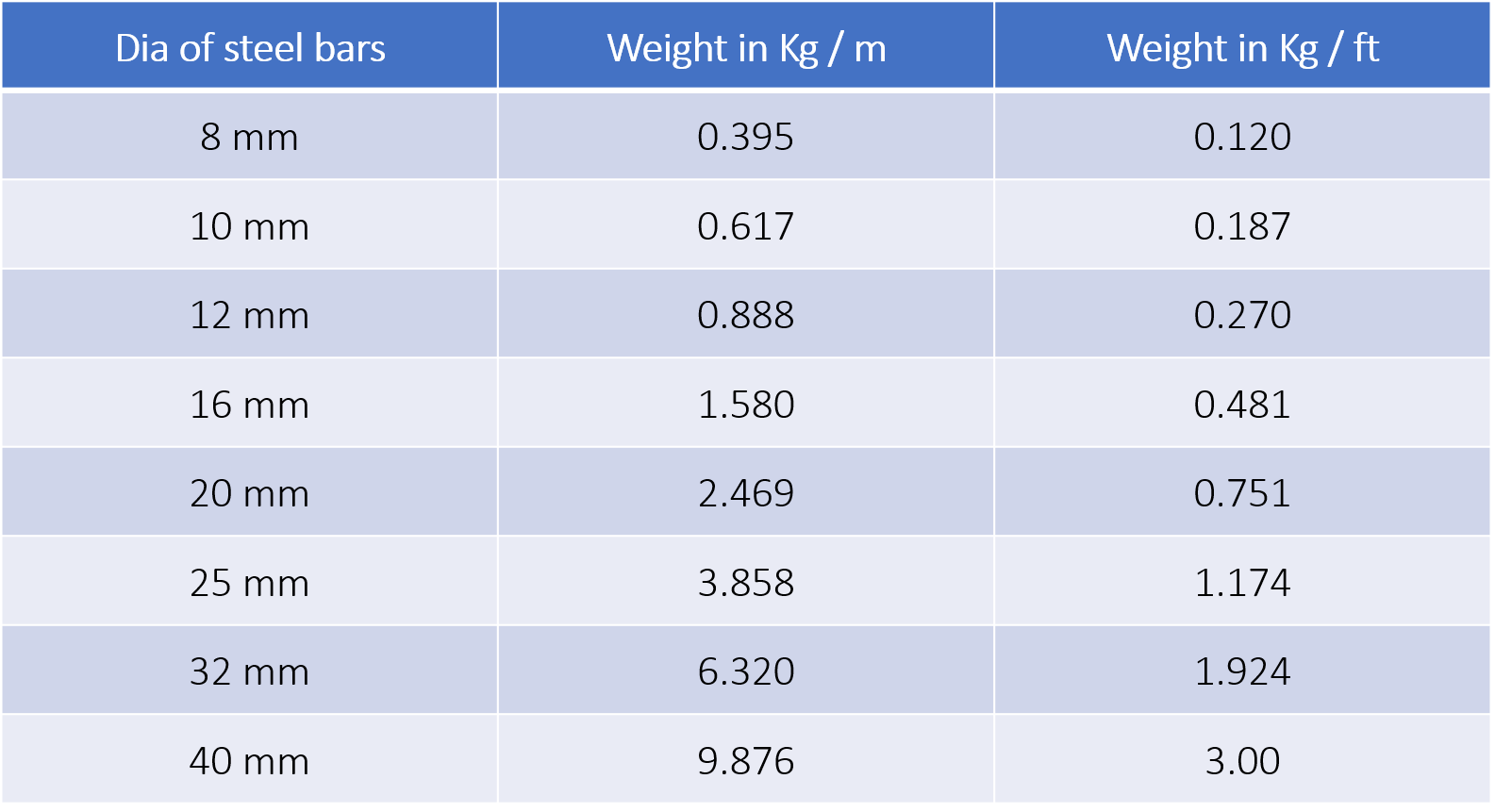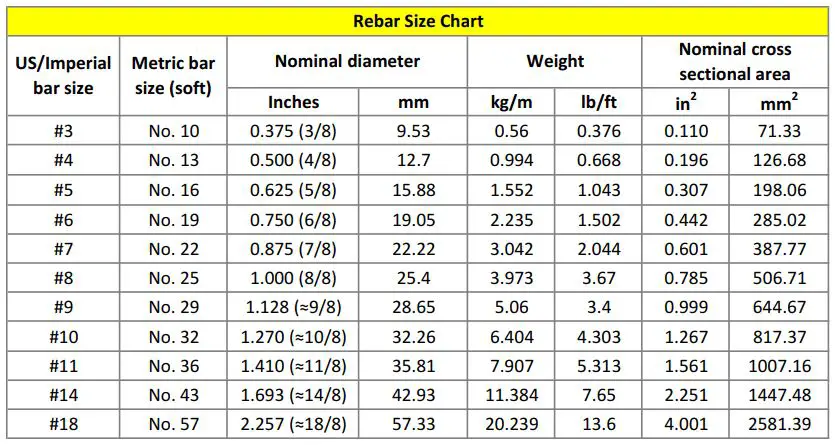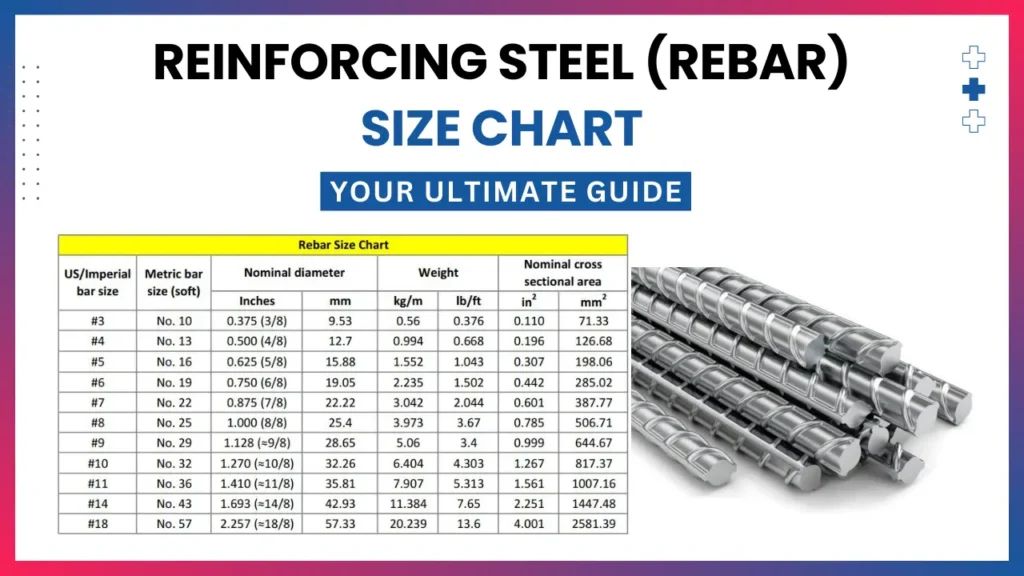The reinforcing bar (Rebar) is one of the most widely used construction materials around the world.
Even though it is not visible in the final look, it provides the necessary strength and ductility to the concrete structures, making it the unsung hero of the construction.
These rebars come in different sizes, weights, and grades, and you might find them measured in imperial or metric units depending on where you are in the world.
In this article, we are going to break down the key components of the reinforcing steel size chart such as bar number, diameter, weight per foot or meter, cross-sectional area, and more.
What is a reinforcing bar?
Concrete is the second most consumed material in the world and it plays a huge role in shaping our environment. It is very strong and highly durable, similar to a natural stone.
However, it is only good at taking compression loads but not so much when it comes to tension (you know, pulling forces).
In the construction of structures like slabs or beams, tension loads are inevitable. Therefore, we need additional material to strengthen the concrete which is capable of bearing tension forces, offering ductility and good compatibility with the concrete, and most importantly, it should be economical.
Among the various options, steel emerges as one of the most suited materials for reinforcing concrete. It is an alloy of iron and carbon and provides sufficient tensile strength, and ductility to the structure at a low cost and has good compatability with the concrete structures.
That’s why steel is our go-to material for reinforcing concrete.
Reinforcing steel size chart
Now that we’ve gained a better understanding of why steel serves as a better reinforcing material, let’s delve into the essential components of the reinforcing steel size chart.
1) Rebar size
A rebar is designated by its size. It can be mentioned either in imperial or metric units depending on where you are in the world.
a) US sizes
In the US, for rebar charts, the imperial system is used.
The size of the rebar is designated by a symbol ‘#’ followed by a number. The symbol ‘#’ indicates the number sign.
For example: ‘#3’ is read as Number 3 bar. It can also be read as “Three-bar.”
The use of the symbol # is customary for the US sizes. Sometimes, instead of the symbol, the term ‘No.’ is also used.
In the US, the rebars come in different sizes ranging from #3 to #11, #14 and #18.
Sizes smaller than #3 are no longer recognized as standard sizes. They are typically referred to as wire products and not bars.
The bar number represents the approximate diameter of the bar in 1/8-inch increments. It is only applicable for bars in the range of #3 – #8. Bars larger than #8 follow the 1/8-inch rule imperfectly with some minor errors.
For example,
- A #3 bar has a diameter of about 3/8 inches (9.53 mm).
- A #4 bar has a diameter of about 4/8 inches (or) ½ inches (12.7 mm).
When the US/imperial sized rebars are used in a project with metric units, the size of the bar is represented by its equivalent metric size.
The term equivalent metric size typically refers to the nominal diameter of the bar rounded to the nearest millimeter. These are not considered as the standard metric sizes and thus are often referred to as a soft conversion or the “soft metric” size.
| US/Imperial bar size | Metric bar size (soft) | Nominal diameter | |
| Inches | mm | ||
| #3 | No. 10 | 0.375 (3/8) | 9.53 |
| #4 | No. 13 | 0.500 (4/8) | 12.70 |
| #5 | No. 16 | 0.625 (5/8) | 15.88 |
| #6 | No. 19 | 0.750 (6/8) | 19.05 |
| #7 | No. 22 | 0.875 (7/8) | 22.22 |
| #8 | No. 25 | 1.000 (8/8) | 25.40 |
| #9 | No. 29 | 1.128 (≈9/8) | 28.65 |
| #10 | No. 32 | 1.270 (≈10/8) | 32.26 |
| #11 | No. 36 | 1.410 (≈11/8) | 35.81 |
| #14 | No. 43 | 1.693 (≈14/8) | 42.93 |
| #18 | No. 57 | 2.257 (≈18/8) | 57.33 |
b) Indian rebar sizes
In India, steel rebars are available in various sizes and are designated by a specific number. These numbers represent the diameter of the bar.
The different sizes of rebar used in India are,
6mm, 8mm, 10mm, 12mm, 16mm, 20mm, 25mm, 32mm.
It is important to note that the sizes may vary depending on regional standards.
2. Rebar weight chart
Another important parameter is the weight of the rebar. The quantity of rebar required is measured in its weight. In order to purchase rebars from the shop, you need the weight of rebars required either in kgs, lbs, or tonnes.
Here’s how you can calculate the weight of the rebar,
Weight of the rebar = c/s area of the rebar x length of rebar x density of steel
Density of steel = 7850 kg/m3
Let’s consider, you want to calculate the weight of 10mm bar of 2m.
Both the length of the rebar and the density of steel are in meters, so let’s convert the diameter of the bar into meters. (10mm = 0.01m)
Weight of the rebar = ((π x 0.012)/4) x 2 x 7850 = 1.23 kg.
However, this might seem somewhat complex, don’t you think? That’s why we have some simplified formulas.
Weight of steel bar of 1m length = D2 /162.27 Kg. Where,
- D = Diameter of the bar in mm.
- The term 162.27 can be rounded to 162.
Weight of steel bar of 1 foot length = D2 /532.27 kg. Where,
- D = Diameter of the bar in mm.
- The term 532.27 can be rounded to 532.
If you want to know more about the derivation behind this formula, check out this article.
How to find the weight of steel bars used in construction?
Let’s check our previous calculation using this formula,
Given data:
- 10 mm bar
- 2m length
Calculation:
Weight of steel bar of 1m length = D2 /162.27 = 102/162.27 = 0.616 kg
Thus, the weight of a steel bar of 2m length = 0.616 x 2 = 1.23 kg.
a) U.S Rebar weight chart
The below table shows the weight of steel bars of varying sizes.
| US/Imperial bar size | Metric bar size (soft) | Nominal diameter (mm) | Weight of rebar in | |
| Kg/m | lb/ft | |||
| #3 | No. 10 | 9.53 | 0.560 | 0.376 |
| #4 | No. 13 | 12.70 | 0.994 | 0.668 |
| #5 | No. 16 | 15.88 | 1.552 | 1.043 |
| #6 | No. 19 | 19.05 | 2.235 | 1.502 |
| #7 | No. 22 | 22.22 | 3.042 | 2.044 |
| #8 | No. 25 | 25.40 | 3.973 | 3.670 |
| #9 | No. 29 | 28.65 | 5.060 | 3.400 |
| #10 | No. 32 | 32.26 | 6.404 | 4.303 |
| #11 | No. 36 | 35.81 | 7.907 | 5.313 |
| #14 | No. 43 | 42.93 | 11.384 | 7.650 |
| #18 | No. 57 | 57.33 | 20.239 | 13.60 |
To convert kg/m to lb/ft, you can use the following conversion factor.
1 kg/m=0.671 lb/ft.
b) Indian Rebar weight chart

Consolidated Reinforcing Steel Size Chart
Now that we have delved into the details of reinforcing steel, it’s time to consolidate all the concepts we’ve explored into a user-friendly chart.
This visual table will serve as a handy reference, providing a clear overview of rebar sizes, weights, and key components discussed throughout the article.

Hope you understand everything you need to know about the rebar size chart. If you found this article helpful, let us know in the comment section.
Read more:
Types of steel rebars used in the construction industry
Concrete Mix Ratio: Exploring Types, Grades, and Strengths
How To Calculate The Quantities Of Materials In Concrete? | Concrete Material calculation
Complete Reinforcement Details For Columns, Beams, and Slabs


